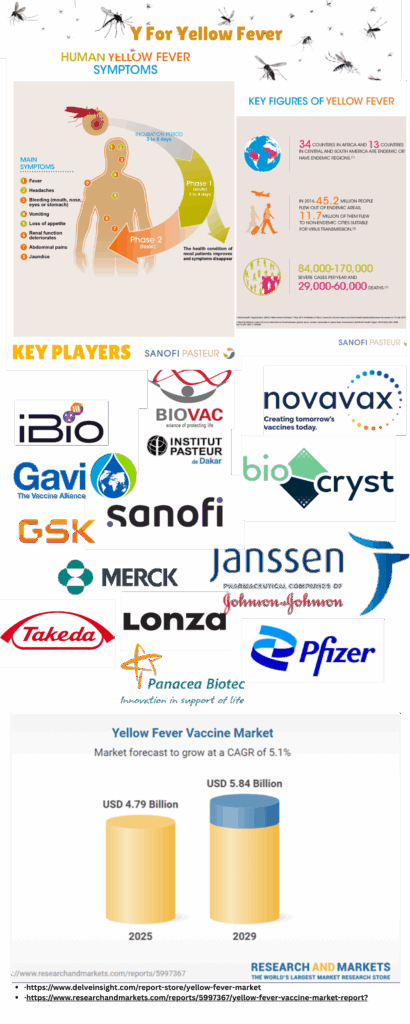Yellow fever is a serious, mosquito-borne viral disease caused by a flavivirus, primarily affecting regions in tropical and subtropical Africa and South America. Although it is rare in countries like the United States, where the disease is not endemic, yellow fever remains a significant public health concern in parts of the world where the virus is actively transmitted. The disease is spread by infected mosquitoes, particularly species from the Aedes and Haemagogus genera, which acquire the virus from infected humans or primates and pass it on through bites.
Clinical Description, classification and symptoms
| Classification Level | Disorder |
| Prevalence | NA |
| Age of Onset | All ages |
| Inheritance | NA |
Following an incubation period of 3 to 6 days, the disease typically begins with non-specific symptoms such as fever, headache, muscle pain, nausea, vomiting, and fatigue. While most cases are mild or asymptomatic, a small percentage of patients enter a more toxic phase after a brief recovery period. During this stage, symptoms may escalate to jaundice, kidney and liver failure, hemorrhagic manifestations, shock, and sometimes death. Case fatality rates among those with severe disease can range from 20% to 50%. There are two main transmission cycles: the sylvatic or jungle cycle, where the virus circulates between mosquitoes and non-human primates, and the urban cycle, where mosquitoes transmit the virus between humans in densely populated areas. Yellow fever presents in a range of clinical forms, from mild, flu-like symptoms to severe, life-threatening illness. Initial symptoms typically include sudden onset of fever, chills, headache, muscle pain (especially in the back), nausea, vomiting, and fatigue. In about 15% of cases, the disease progresses to a more severe “toxic phase” after a short period of remission. This phase is characterized by jaundice (yellowing of the skin and eyes), bleeding from the gums or other sites, vomiting of blood (often referred to as “black vomit”), kidney and liver dysfunction, and eventually shock. Approximately half of patients who develop the toxic phase die within 7 to 10 days.
Diagnosis and Treatment
Yellow fever remains a significant public health concern, particularly in Africa, where about 90% of all infections occur. Each year, there are an estimated 84,000–170,000 severe cases and 29,000–60,000 deaths in Africa alone. The global burden is estimated to be between 5,000 to 200,000 clinical cases annually. Yellow fever therapy primarily focuses on prevention through vaccination, as there is no specific antiviral treatment currently available. Diagnosis relies on specialized tests such as RT-PCR, ELISA, and IFA, which are typically limited to reference laboratories.
Sanofi is the sole manufacturer of YF-VAX, the yellow fever vaccine licensed in the United States and also supplies Stamaril under an Investigational New Drug (IND) program when YF-VAX is limited. The vaccine is only administered at CDC-certified Yellow Fever Vaccination Centers, and it is recommended for individuals traveling to or living in areas where yellow fever is endemic. Some countries require proof of vaccination for entry. Globally, the World Health Organization (WHO) supports widespread vaccination campaigns in at-risk regions, particularly in sub-Saharan Africa and parts of South America, where yellow fever transmission is most prevalent. Mass immunization efforts, often coordinated with organizations like Gavi, the Vaccine Alliance, have played a critical role in reducing outbreaks. In these regions, early detection and rapid response are essential due to limited healthcare infrastructure. For those who become infected, treatment is limited to supportive care such as rest, fluids, and symptom management, while severe cases may require intensive care to manage complications like liver or kidney failure. Research is ongoing to develop targeted therapies, including lab-created monoclonal antibodies, with companies like Mabloc LLC and Oregon Health & Science University (OHSU) collaborating on new approaches. Experimental antivirals and repurposed drugs are also being studied, although none are currently approved for yellow fever treatment. Public health measures, including vaccination, mosquito control, and traveler awareness, are essential to prevent future outbreaks. As urbanization and global travel increase, maintaining high vaccination coverage and improving vaccine supply will be critical in the fight against yellow fever.

Image: Symptoms and Key figures for Yellow Fever; Key Players and Market statistics involved in Yellow Fever Vaccine
The yellow fever vaccine market has experienced robust growth in recent years and is projected to increase from $4.54 billion in 2024 to $4.79 billion in 2025, reflecting a compound annual growth rate (CAGR) of 5.4%. This growth during the historical period has been driven by the launch of global immunization initiatives, the enforcement of international health regulations, widespread mass vaccination efforts, and significant advancements in vaccine manufacturing technologies.
For more on rare diseases, stay tuned for the next installment of Care for Rare. Meanwhile, click here for more available resources and support groups for yellow fever.
Dr. Malini Gupta, Ph.D.
Sources
- https://www.orpha.net/en/disease/detail/99829
- https://rarediseases.org/rare-diseases/yellow-fever/
- https://wwwnc.cdc.gov/travel/yellow-fever-vaccination-clinics/search
- https://www.delveinsight.com/report-store/yellow-fever-market
- https://www.researchandmarkets.com/reports/5997367/yellow-fever-vaccine-market-report?
- https://www.osmosis.org/learn/Yellow_fever_virus
- https://boonedrug.com/yellow-fever-vaccine
Disclaimer
The editors take care to share authentic information. In case of any discrepancies please write to newsletter@medness.org
The sponsors do not have any influence on the nature or kind of the news/analysis reported in MedNess. The views and opinions expressed in this article are those of the authors and do not necessarily reflect the official policy or position of MedNess. Examples of analysis performed within this article are only examples. They should not be utilized in real-world analytic products as they are based only on very limited and dated open-source information. Assumptions made within the analysis are not reflective of the position of anyone volunteering or working for MedNess. This blog is strictly for news and information. It does not provide medical advice, diagnosis or treatment nor investment suggestions. This content is not intended to be a substitute for professional medical advice, diagnosis, or treatment. Always seek the advice of your physician or another qualified health provider with any questions you may have regarding a medical condition. Never disregard professional medical advice or delay in seeking it because of something you have read on this website.
MedNess is a part of STEMPeers® which is a 501(c)(3) organization registered in PA as PhD Career Support Group. The organization helps create a growing network of STEM scientists that is involved in peer-to-peer mentoring and support.



